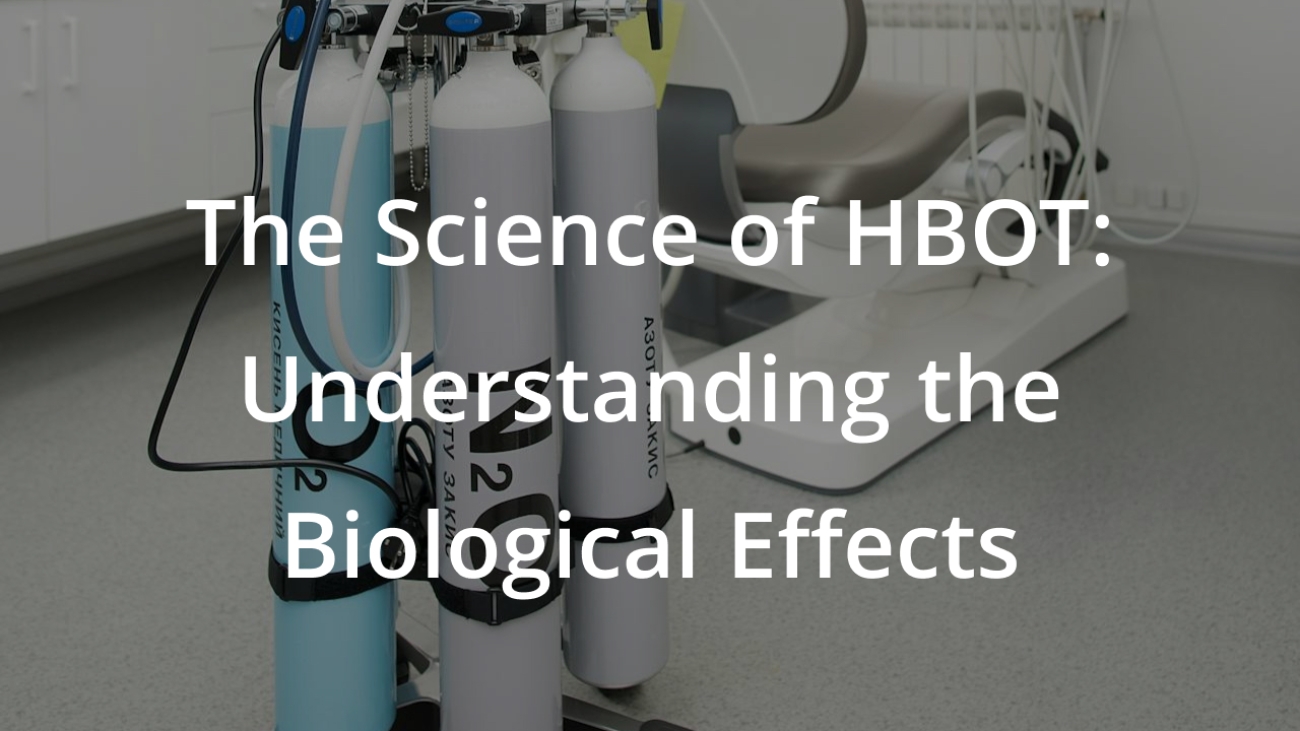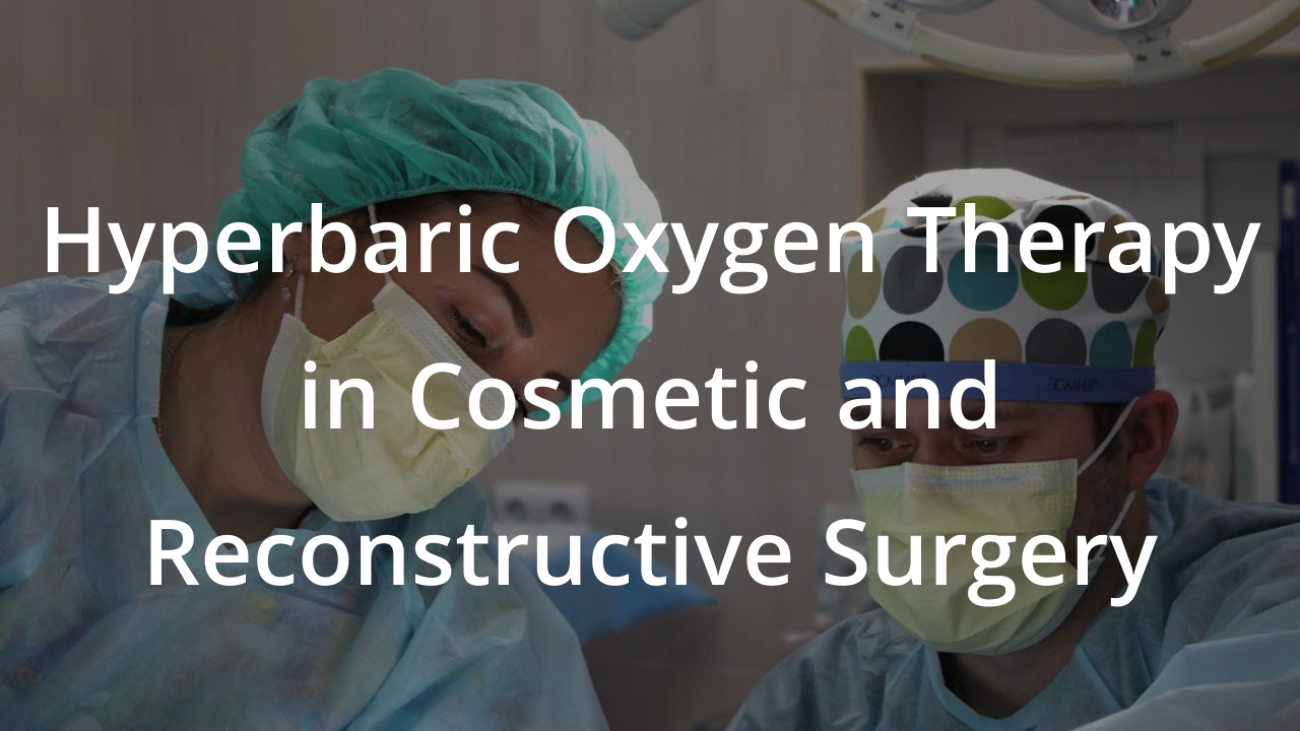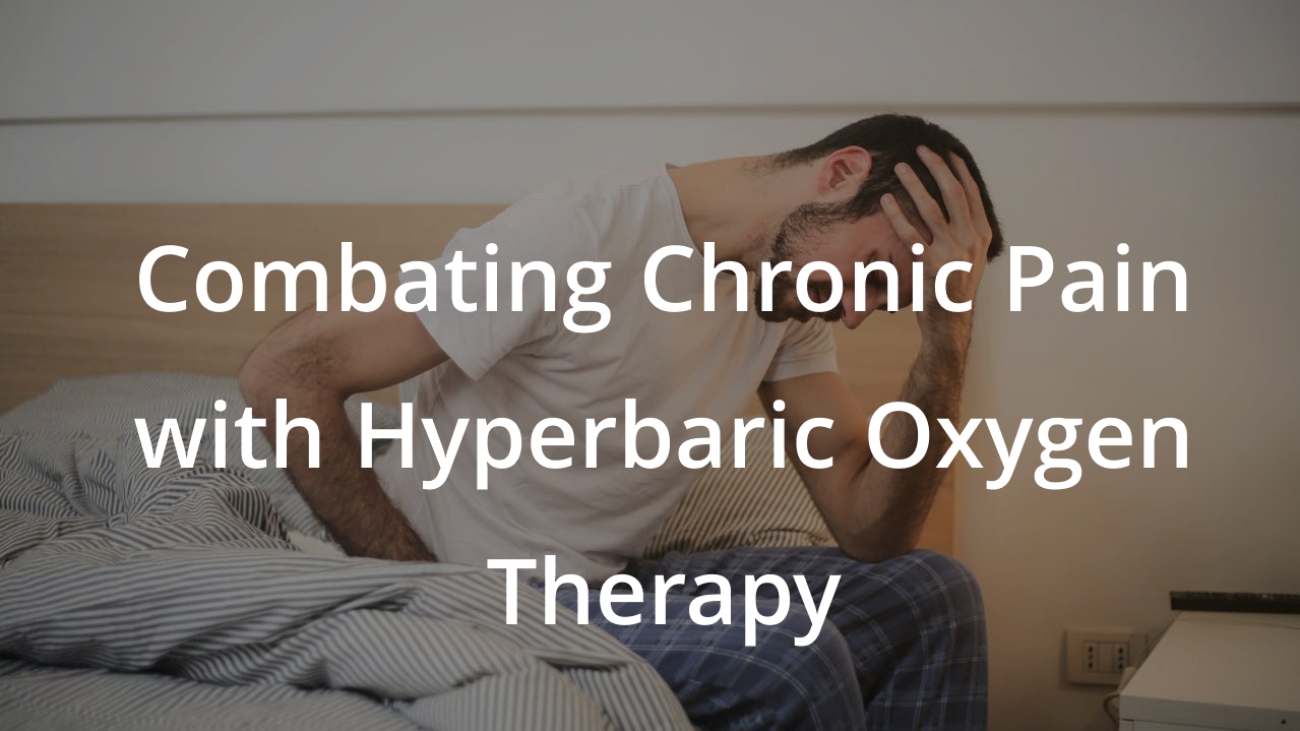This blog explores the biological effects of HBOT, providing insights into why this therapy is so effective.
Hyperbaric Oxygen Therapy in Cosmetic and Reconstructive Surgery
This blog delves into the benefits of HBOT in cosmetic and reconstructive surgery, providing insights into how this innovative therapy can optimize post-surgical recovery.
Combating Chronic Pain with Hyperbaric Oxygen Therapy
Chronic pain is a pervasive issue affecting millions of individuals worldwide, significantly diminishing their quality of life. Traditional pain management strategies often include medications, physical therapy, and, in some cases, surgery. However, Hyperbaric Oxygen Therapy (HBOT) is emerging as a powerful adjunct in the fight against chronic pain. At Under Pressure Hyperbarics, we explore the potential of HBOT to alleviate chronic pain through enhanced oxygenation and its various physiological effects. This blog will explore how HBOT can be integrated into a comprehensive treatment plan for chronic pain, emphasizing the underlying mechanisms that make it an effective therapy.
Understanding HBOT
HBOT involves breathing pure oxygen in a pressurized environment, significantly increasing the oxygen concentration in the blood. This process allows oxygen to be dissolved at a higher rate into the blood plasma, reaching deeper into tissues to promote healing and pain relief that might not be accessible through normal atmospheric conditions.
Mechanisms of HBOT in Pain Management
- Enhanced Tissue Oxygenation: One of the primary mechanisms by which HBOT aids pain management is enhanced tissue oxygenation. By increasing oxygen supply to hypoxic (oxygen-starved) tissues, HBOT helps repair damaged cells and promote tissue regeneration, which is often hindered in chronic pain conditions.
- Reduction of Inflammation: Chronic inflammation is commonly seen in many pain conditions, including fibromyalgia and rheumatoid arthritis. HBOT has been shown to reduce inflammation by downregulating pro-inflammatory cytokines and enhancing anti-inflammatory cytokines, helping to alleviate pain and swelling.
- Neovascularization: HBOT promotes the formation of new blood vessels, a process known as neovascularization. This increases blood flow to affected areas, improving oxygen delivery and waste removal, which is crucial for healing and pain reduction.
- Modulation of Neural Function: Evidence suggests that HBOT can help modulate neural function, reducing the pain signal intensity transmitted to the brain. This can help patients experience less pain and improve their functional capabilities.
Clinical Evidence Supporting HBOT for Chronic Pain
Research studies have demonstrated the efficacy of HBOT in treating various types of chronic pain. For instance, patients suffering from complex regional pain syndrome (CRPS), a particularly severe chronic pain condition, have reported significant pain reduction following a series of HBOT sessions. Similarly, those with fibromyalgia have experienced relief in terms of both pain intensity and overall quality of life.
Integrating HBOT into a Comprehensive Pain Management Plan
- Initial Assessment: Patients interested in HBOT for chronic pain first undergo a thorough medical evaluation at Under Pressure Hyperbarics to determine if they are suitable candidates for the therapy and to identify the specific treatment parameters.
- Customized Treatment Sessions: Based on individual needs, several HBOT sessions are scheduled, often in conjunction with other ongoing treatments. Each session typically lasts around 90 minutes, during which patients can relax, sleep, or listen to music inside the chamber.
- Monitoring and Adjustment: Patient progress is closely monitored throughout the treatment process. Based on individual responses, adjustments to the therapy protocol may be made, with a focus on optimizing outcomes.
At Under Pressure Hyperbarics, we believe in a comprehensive and personalized approach to managing chronic pain. HBOT is most effective when integrated with other pain management strategies. This may include pharmacological treatments, physical therapy, nutritional changes, and psychological counseling, providing a holistic approach that is tailored to your unique needs.
Conclusion
Hyperbaric Oxygen Therapy offers a promising option for individuals suffering from chronic pain, providing relief by addressing the underlying causes of pain rather than merely managing symptoms. At Under Pressure Hyperbarics, we are dedicated to employing this advanced therapy to enhance the lives of our patients, helping them return to more active and fulfilling lives free from the constraints of chronic pain.
If you are suffering from chronic pain and looking for innovative and effective treatment options, consider HBOT. Contact Under Pressure Hyperbarics today to schedule a consultation and learn more about how this therapy could be integrated into your current pain management plan. Together, we can take a proactive step towards managing your pain and improving your overall health and well-being.
HBOT and Mental Health: A New Frontier
In recent years, Hyperbaric Oxygen Therapy (HBOT) has expanded its reach beyond traditional applications like wound healing and decompression sickness to address a range of other health issues, including mental health disorders. At Under Pressure Hyperbarics, we are exploring HBOT’s promising potential to treat conditions such as depression and anxiety. This blog delves into how HBOT may benefit mental health, the mechanisms behind its efficacy, and what this could mean for future treatments in the field of psychiatry.
Understanding HBOT
HBOT involves breathing pure oxygen in a pressurized chamber, significantly increasing oxygen absorption in the blood and tissues. Traditionally used to treat divers with the bends or to enhance wound healing, the therapy is now being studied for its effects on brain function and mental health disorders.
Potential Benefits of HBOT for Mental Health
- Enhanced Brain Function: HBOT can increase blood flow to the brain, which helps rejuvenate brain tissues and enhances overall brain function. This increased oxygenation can potentially alleviate symptoms of mental health disorders such as depression and anxiety by improving brain energy metabolism and reducing inflammation.
- Neuroplasticity: Studies suggest that HBOT may promote neuroplasticity, the brain’s ability to form new neural connections. Enhanced neuroplasticity can lead to improvements in cognitive functions and emotional regulation, which are often compromised in individuals with mental health issues.
- Reduction in Inflammation: Chronic inflammation has been linked to a variety of mental health conditions, including depression and anxiety. By reducing inflammation, HBOT may help alleviate the physiological stressors contributing to these disorders.
- Stress Reduction: The pressurized environment and the breathing techniques used in HBOT can have a calming effect, reducing stress levels and potentially alleviating symptoms of anxiety and stress-related disorders.
Mechanisms Behind HBOT’s Effectiveness in Treating Mental Health
- Oxygen Saturation: The brain uses about 20% of its oxygen, yet many conditions and lifestyle factors can reduce its availability. HBOT increases the amount of dissolved oxygen in the plasma, making more oxygen available to brain tissues, which can improve mood and cognitive functions.
- Anti-inflammatory Effects: HBOT has been shown to reduce inflammation by decreasing pro-inflammatory cytokine levels and increasing anti-inflammatory cytokines. This shift can help in the management of mood disorders, where inflammation often plays a critical role.
- Endorphin Release: Exposure to high oxygen levels during HBOT sessions can stimulate the release of endorphins, the body’s natural painkillers and mood elevators. This endorphin boost can provide immediate relief from symptoms of depression and anxiety.
Research and Evidence
Recent studies have provided encouraging results regarding the use of HBOT for mental health conditions. For example, a controlled trial found that individuals undergoing HBOT showed significant improvements in symptoms of depression and anxiety compared to those receiving other standard treatments. These studies, while still relatively few, point towards the potential for HBOT to become a significant player in mental health treatment.
Considerations and Future Directions
While the early results are promising, HBOT should not be seen as a standalone treatment for mental health disorders. It is most effective with other therapies, such as medication and psychotherapy. Ongoing research and clinical trials are needed to understand further the optimal conditions and treatment protocols for HBOT in mental health care, including session duration, frequency, and pressure levels.
Conclusion
HBOT represents a new frontier in the treatment of mental health conditions, offering hope and a novel approach for patients who may not have responded to traditional therapies. Under Pressure Hyperbarics is committed to advancing our understanding and application of this treatment to support our patients’ mental well-being. If you or someone you know is struggling with depression or anxiety and is interested in exploring innovative treatment options, HBOT might provide the relief and recovery needed. Contact us today to learn more about how HBOT can be integrated into a comprehensive mental health care plan.
The Role of HBOT in Post-Surgical Recovery
Hyperbaric Oxygen Therapy (HBOT) is gaining traction as an invaluable tool in post-surgical recovery. At Under Pressure Hyperbarics, we’ve witnessed firsthand how HBOT can significantly enhance healing and reduce complications for patients recovering from various surgical procedures. This blog explores the mechanisms behind HBOT’s effectiveness in post-surgical scenarios, its benefits, and the types of surgeries that can benefit from this advanced therapy.
Understanding HBOT in Post-Surgical Recovery
Mechanism of Action
HBOT involves breathing 100% oxygen at increased atmospheric pressure in a specialized chamber. This process significantly improves the patient’s blood oxygen saturation, delivering more excellent oxygen to tissues. For post-surgical patients, this means enhanced cellular functions vital for healing, including fibroblast activation, collagen production, and angiogenesis—forming new blood vessels.
Accelerating Healing Processes
Reducing Inflammation and Swelling
One of HBOT’s primary benefits in post-surgical recovery is its ability to reduce inflammation and swelling. By enhancing oxygen delivery to damaged tissues, HBOT helps to reduce fluid buildup and decrease swelling more rapidly than would typically occur, allowing for quicker wound healing and reduced pain.
Stimulating Collagen Production
Collagen is a critical protein in wound healing, providing skin structure and strength. The increased oxygen levels provided by HBOT stimulate fibroblasts—cells that play a crucial role in healing—to produce collagen at accelerated rates, thereby speeding up the wound-healing process.
Promoting Angiogenesis
HBOT encourages the formation of new blood vessels in healing tissues, which improves blood flow to areas that need it most. Enhanced blood flow delivers vital nutrients and removes waste products from the wound site, further promoting healing.
Reducing Complications
Minimizing Infection Risk
HBOT has been shown to boost the body’s immune response, which can help prevent infections, a common complication after surgery. The high oxygen levels at the wound site create an environment less favorable for bacteria that thrive in low-oxygen conditions.
Enhancing Antibiotic Efficacy
For patients requiring antibiotics post-surgery, HBOT can increase the efficacy of these drugs. The elevated oxygen levels can help antibiotics work more effectively, particularly those that require oxygen to be efficacious.
Types of Surgeries That Benefit from HBOT
Orthopedic Surgeries: Patients recovering from joint replacements or bone fracture repairs can benefit from HBOT’s ability to accelerate bone healing and reduce the risk of complications such as infections or bone non-union.
Plastic and Reconstructive Surgeries: For those undergoing surgeries that involve skin grafts or flaps, HBOT can significantly enhance graft survival, improve outcomes, and decrease recovery time.
Abdominal Surgeries: Patients who undergo abdominal operations can benefit from HBOT, which can heal incisions faster and reduce the potential for abdominal infections.
Conclusion
The role of HBOT in post-surgical recovery represents a paradigm shift in how we approach healing and rehabilitation. Its ability to enhance the body’s natural healing processes shortens recovery times, improves overall outcomes, and reduces the risk of post-operative complications. At Under Pressure Hyperbarics, we are committed to providing our patients access to state-of-the-art HBOT technology and the highest standards of care.If you or a loved one are preparing for surgery or are currently in the recovery phase, consider HBOT as a means to enhance your healing journey. Contact us at Under Pressure Hyperbarics to learn how this therapy can be integrated into your post-surgical recovery plan, helping you return to total health more quickly and effectively.
HBOT for Enhancing Athletic Performance
This blog explores how HBOT works, its benefits for athletes, and why it might be a game-changer in sports recovery and performance enhancement.
HBOT and Its Anti-Aging Benefits
This blog explores how HBOT can contribute to anti-aging efforts, providing insights into the scientific mechanisms driving its benefits.
Navigating Hyperbaric Oxygen Therapy Centers: Finding the Right Fit
Hyperbaric Oxygen Therapy (HBOT) has emerged as a valuable treatment option for various medical conditions, ranging from chronic wounds to neurological disorders. As interest in this therapeutic approach grows, it’s essential to navigate the landscape of Hyperbaric Oxygen Therapy Centers to find the right fit for your needs. This guide aims to assist readers in making informed decisions when choosing a hyperbaric clinic, considering factors such as proximity, sessions, treatment options, physician oversight and the crucial aspect of certification.
Proximity Matters
When exploring hyperbaric oxygen therapy options, one of the first considerations should be proximity. Choose a center that is conveniently located, making it easier to adhere to the recommended treatment schedule. Proximity not only eases the logistical aspects of attending sessions but also contributes to a more consistent and effective treatment plan.
Hyperbaric Oxygen Sessions
Understanding the frequency and duration of hyperbaric oxygen sessions is vital. Different medical conditions may require varying session length, pressure and frequencies. Ensure that the chosen hyperbaric clinic can accommodate your specific treatment plan. Additionally, inquire about the flexibility of session scheduling to better align with your daily routine.
Treatment Options and Expertise
Not all hyperbaric oxygen therapy centers offer the same range of treatments or specialize in the same medical conditions. Research the specific expertise of each center and ensure that they provide the treatments relevant to your health needs. Not all centers offer physician oversight and supervision. A diverse range of treatment options indicates a comprehensive approach to hyperbaric therapy.
Certification: A Non-Negotiable Factor
Certification is a non-negotiable factor when selecting a hyperbaric oxygen therapy center. Ensure that the facility is accredited and follows industry standards for safety and quality of care. Certification guarantees that the center meets the necessary protocols, employs trained professionals, and operates under stringent safety measures, providing peace of mind for patients seeking hyperbaric treatments.
Patient Reviews and Testimonials
Explore patient reviews and testimonials to gain insights into the experiences of others who have undergone hyperbaric oxygen therapy at the center. Positive feedback regarding staff professionalism, facility cleanliness, and successful outcomes can help build confidence in your decision.
Consultation and Facility Tour
Before committing to a hyperbaric oxygen therapy center, schedule a consultation and request a facility tour. This allows you to meet the staff, ask any questions you may have, and evaluate the overall atmosphere of the center. A well-maintained and welcoming facility can contribute to a positive treatment experience.
Conclusion
Choosing the right hyperbaric oxygen therapy center involves careful consideration of factors such as proximity, session flexibility, treatment options, and, most importantly, certification. By taking the time to research and assess these aspects, you can ensure that your journey with hyperbaric oxygen therapy is not only effective but also conducted in a safe and reputable environment.
For those in the Los Angeles area, we recommend exploring the services provided by Under Pressure Hyperbarics. With a commitment to excellence, certified facilities, and a range of treatment options, Under Pressure Hyperbarics is dedicated to providing top-notch care. Take the next step towards optimized health by scheduling a consultation with Under Pressure Hyperbarics today.
Revitalizing Health: Oxygen Therapy for Specific Conditions
Oxygen therapy, a treatment that involves breathing pure oxygen in a pressurized environment or through a mask, has been recognized for its potential benefits in treating a range of health conditions. This blog explores how oxygen therapy can be a game-changer for individuals suffering from migraines, diabetes, fatigue, inflammation, and sleep apnea, backed by the latest research findings.
Oxygen Therapy for Migraines
Migraines are more than just headaches; they are intense, often debilitating episodes of pain. Oxygen therapy, particularly hyperbaric oxygen therapy (HBOT), has shown promise in reducing the intensity and frequency of migraine attacks. By increasing oxygen levels in the blood, it is believed to reduce inflammation and pain associated with migraines. Research indicates that regular sessions can lead to fewer migraine days for sufferers.
Oxygen Therapy for Diabetes
Diabetes affects the body’s ability to heal and increases the risk of infections, particularly in extremities. Oxygen therapy has been utilized to enhance wound healing in diabetic patients, especially those with foot ulcers. By delivering a high concentration of oxygen to the body’s tissues, it promotes faster healing and reduces the risk of complications. Studies have shown significant improvements in wound healing rates among diabetics undergoing HBOT.
Oxygen Therapy for Fatigue
Chronic fatigue can drastically impact one’s quality of life. Oxygen therapy has been explored as a treatment to improve energy levels and alleviate symptoms of fatigue. The increased oxygen supply is thought to enhance mitochondrial function and energy production within cells. While more research is needed, preliminary studies suggest a potential reduction in fatigue symptoms with regular oxygen therapy sessions.
Oxygen Therapy for Inflammation
Inflammation is a natural response of the body to injury or infection, but chronic inflammation can lead to various health issues. Oxygen therapy can play a role in reducing inflammation by enhancing the body’s immune response and reducing oxidative stress. This is particularly beneficial in conditions like inflammatory bowel disease, arthritis, and other chronic inflammatory conditions. Emerging research supports the anti-inflammatory effects of oxygen therapy, indicating its potential as a complementary treatment.
Oxygen Therapy for Sleep Apnea
Sleep apnea is a disorder characterized by pauses in breathing during sleep, leading to disrupted sleep and decreased oxygen levels. Oxygen therapy, often in the form of continuous positive airway pressure (CPAP), is a standard treatment for sleep apnea. It ensures a constant flow of air, preventing airway collapse and maintaining adequate oxygen levels throughout the night. Numerous studies have demonstrated the effectiveness of CPAP in improving sleep quality and reducing the health risks associated with sleep apnea.
Conclusion
Oxygen therapy offers a breath of fresh air for individuals battling migraines, diabetes, fatigue, inflammation, and sleep apnea. While it’s not a cure-all, its potential benefits make it a compelling option for those seeking relief from these conditions. As with any treatment, it’s crucial to consult with a healthcare professional to determine if oxygen therapy is suitable for your specific needs.
If you’re interested in exploring how oxygen therapy can revitalize your health, schedule your consultation today to discuss the latest research and personalized treatment options.
Exploring HBOT and Alzheimer’s
Alzheimer’s disease, a progressive neurodegenerative disorder, profoundly impacts memory, cognition, and daily functioning. As researchers seek effective treatments, Hyperbaric Oxygen Therapy (HBOT) has emerged as a potential therapeutic approach. This blog delves into the potential benefits of HBOT for individuals with Alzheimer’s, discussing relevant studies and considerations for exploring this treatment option.
Understanding HBOT in the Context of Alzheimer’s
Hyperbaric Oxygen Therapy involves breathing pure oxygen in a pressurized environment, which increases oxygen concentration in the bloodstream and, subsequently, in body tissues. This enhanced oxygenation has been known to aid in wound healing and treating decompression sickness, but its potential effects on neurodegenerative diseases like Alzheimer’s are currently under investigation.
Potential Benefits of HBOT for Alzheimer’s
The rationale behind using HBOT for Alzheimer’s lies in its ability to potentially address several aspects of the disease:
Increased Brain Oxygenation: HBOT may improve oxygen delivery to the brain, potentially mitigating some effects of Alzheimer’s on brain function.
Reduction of Inflammation: Chronic inflammation is a hallmark of Alzheimer’s. HBOT could play a role in reducing this inflammation, thus slowing disease progression.
Enhancement of Cognitive Function: Some studies suggest that HBOT may improve cognitive functions in Alzheimer’s patients, although this area needs more research.
Review of Studies on HBOT and Alzheimer’s
Early-stage Studies: Most studies are in their preliminary stages, with small sample sizes and short follow-up periods.
Promising Results: Some studies have reported improvements in cognitive function and quality of life in Alzheimer’s patients following HBOT.
Need for More Research: The medical community agrees that more comprehensive, long-term studies are needed to conclusively determine HBOT’s effectiveness in treating Alzheimer’s.
Considerations for HBOT in Alzheimer’s
For individuals considering HBOT for Alzheimer’s, several factors need consideration:
Medical Consultation: It’s essential to consult with healthcare professionals experienced in both Alzheimer’s and HBOT to understand the potential risks and benefits.
Commitment and Accessibility: HBOT treatment requires multiple sessions, which can be time-consuming and may not be readily accessible everywhere.
Individual Responses: Alzheimer’s is a complex disease, and responses to any treatment, including HBOT, can vary significantly between individuals.
Conclusion
Hyperbaric Oxygen Therapy offers a novel and intriguing approach to potentially easing the symptoms of Alzheimer’s disease. While initial studies show promise, the medical community is still in the early stages of understanding its full impact. For those considering HBOT as a treatment option for Alzheimer’s, a thorough evaluation by medical professionals, an understanding of the commitment involved, and careful consideration of the costs and potential benefits are essential. As research progresses, HBOT may become an integral part of the multifaceted approach required to manage Alzheimer’s disease effectively. Schedule your consultation with Under Pressure today!









